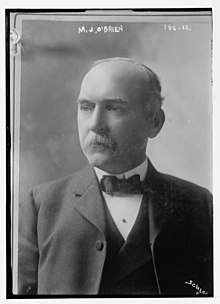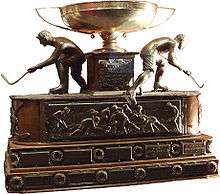Michael John O'Brien
Michael John O'Brien (19 September 1851 – 26 October 1940) was a railway builder, industrialist and philanthropist. He was named to the Senate of Canada in 1918. He was a founder of the town of Renfrew, Ontario.[1]

Early life
O'Brien was born in Lochaber, Nova Scotia to Irish immigrant John O'Brien (1799 - 1869) and his wife, Mary Elizabeth Cleary O'Brien (1832 - 1900), daughter of Michael Cleary and Elizabeth Foley. He attended school until Grade 8, quitting at age 14 for a water boy position at a railway construction site.[2]
Career
Having started as a water boy, O'Brien was subcontracting for railroad work by the age of 18, then followed the new railways across the country during the early heyday of rapid railway expansion in Canada.[3] He arrived in Renfrew, Ontario as a teenager and, in 1879, he and two partners won the contract to build the Kingston and Pembroke Railway (K & P). While walking the future rail path between Sharbot Lake to the town of Renfrew, he happened to meet the Barry family, including his future first wife, Jane "Jenny" Barry, where her father, James, had built their home on the south shore of Calabogie Lake.[4] In 1891 he went bankrupt, after a disastrous contract for the Canada Atlantic Railway, then rebuilt his wealth through construction contracts.
While Commissioner of the Temiskaming and Northern Ontario Railway, from 1902 to 1905; O'Brien, in 1903, bought four claims that would become the O'Brien silver mine in Cobalt, Ontario from prospector Neil King for $4,000, then "promptly sued the owners of the adjacent LaRose claim for a piece of conflicting property."[5][6][7] The La Rose claim had been bought from Fred La Rose by the Timmins and McMartin brothers; a protracted legal battle ensued between the "O'Brien crowd" and the "LaRose people", collectively, "The Big Cobalters", which "caught the Whitney government in the cross-fire," before a publicly profitable conclusion was devised by the Ontario government in 1906.[8][9]
His influence in Renfrew and the surrounding area included a dairy, woolens and knit factories, and saw and planing mills. During World War I, O'Brien recruited and equipped several battalions of railway workers.[10]
NHA

Senator O'Brien's son, Ambrose, played varsity ice hockey at the University of Toronto;[11] after graduation, Ambrose founded several hockey teams, financed by M.J., including teams in Cobalt, Haileybury, Montreal and Renfrew, which all played in the first season of the National Hockey Association (NHA), an organization co-founded by Ambrose in 1909, that became the forerunner of the National Hockey League.[12][13]
O'Brien funded four the NHA league's five teams, including the Renfrew Creamery Kings, founded by Ambrose, and popularly known as the Renfrew Millionaires because of O'Brien's definitive resource; the team was later renamed the Montreal Canadiens, "possibly the most storied franchise in Canadian sport."[14]
He donated the O'Brien Cup to the league, which was used until 1950 by the National Hockey League and is in the collection of the Hockey Hall of Fame.
Legacy
O'Brien was a financial supporter of the preservation of Renfrew's heritage buildings, including its opera house. He served as Senator for Ontario from 1918 to 1925. In 1926 he was made a Knight Commander of the Order of St. Gregory the Great, a decoration bestowed by Pope Pius XI. He died in 1940 in Renfrew.[15]
See also
- National Hockey Association
- Montreal Canadiens
- Renfrew Millionaires
References
- J.P. Bickell: The Life, the Leafs, and the Legacy. Dundurn; 9 September 2017. ISBN 978-1-4597-4047-1. p. 70–.
- MHA Marmora History: Profile of Michael John O'Brien, Deloro Tycoon, Marmora Historical Association. Retrieved April 21, 2018.
- We Lived a Life and Then Some: The Life, Death, and Life of a Mining Town. Between The Lines; 1996. ISBN 978-1-896357-06-5. p. 45–.
- Bytown "M.J. O'BRIEN", Bytown or Bust, May 8, 2012. Retrieved April 21, 2018.
- Nelles, H.V. Politics of Development: Forests, Mines, and Hydro-Electric Power in Ontario, 1849-1941 McGill-Queen's University Press, 2005, page 166.
- Pain, S.A. (1960). Three Miles of Gold. Toronto: The Ryerson Press. pp. 2–3.
- Barnes, Michael (1986). Fortunes in the Ground. Erin, Ontario: The Boston Mills Press. p. 30,44. ISBN 091978352X.
- Nelles, H.V. Politics of Development: Forests, Mines, and Hydro-Electric Power in Ontario, 1849-1941 McGill-Queen's University Press, 2005, page 109.
- Rickard, T. A. Mining and Scientific Press, Volume 93, Dewey Publishing Company, 1906, page 615.
- "Michael John O'Brien". The Canadian Encyclopedia.
- HHOF "Legends of Hockey — Builders", Hockey Hall of Fame. Retrieved April 21, 2018.
- Literary History of Canada: Canadian Literature in English, Volume III (Second Edition). University of Toronto Press, Scholarly Publishing Division; 15 December 1976. ISBN 978-1-4875-9099-4. p. 223–.
- "The Start of the NHL". The Hockey Writers, By Scott Campbell January 6th, 2017
- Cosentino, F. R. The Canadian Encyclopedia, Michael John O'Brien, 2008. Retrieved April 21, 2018.
- Cosentino, Frank (1990). The Renfrew Millionaires: The Valley Boys of Winter 1910. The General Store Publishing House. p. 165. ISBN 0-919431-35-6.
External links
- Michael John O'Brien – Parliament of Canada biography
- Who's who in Canada: An Illustrated Biographical Record of Men and Women of the Time, Volume 15, by Charles Whately Parker and Barnet M. Greene, International Press Limited, Canada,1912, page 1409.
- O'Brien, From Water Boy to One Million A Year, by Scott Young and Astrid Young, (George O'Brien, Editor), Ryerson Press, Toronto, Canada, 1967. ISBN 978-0919431041.